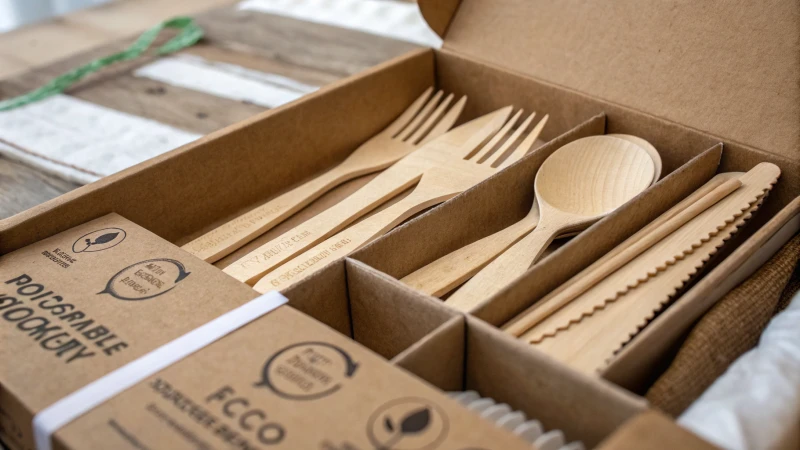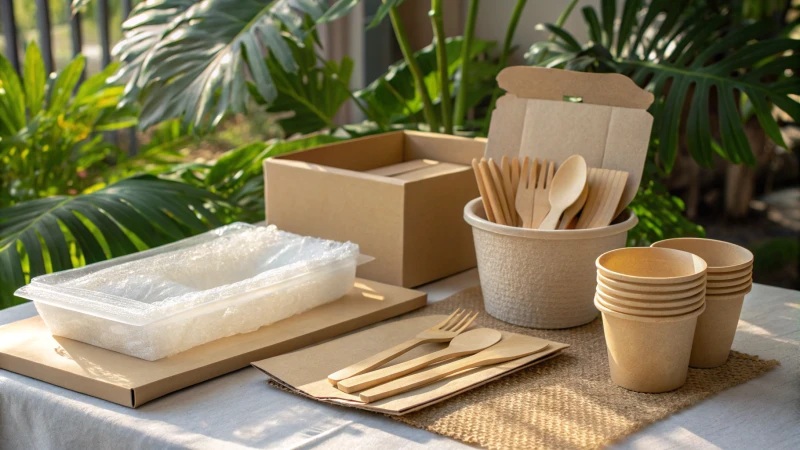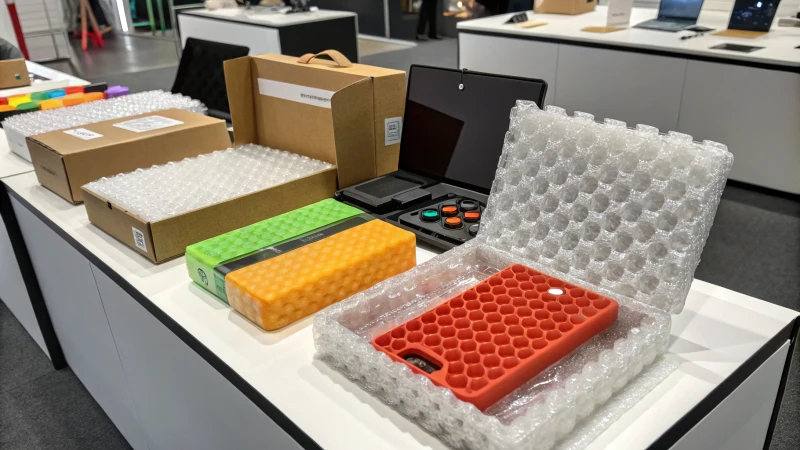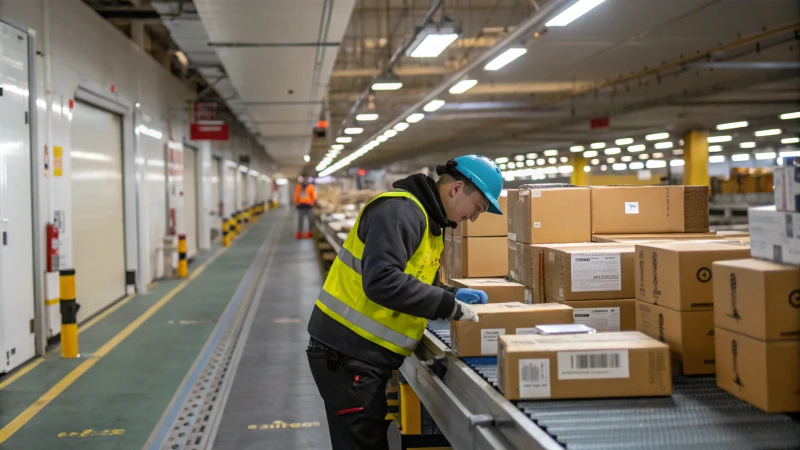
Have you ever worried about your wooden cutlery surviving a long trip? Let me share some tips to ease your mind.
To keep disposable wooden cutlery intact during long-distance shipping, I rely on shockproof packaging materials like cushioned inserts and eco-friendly wraps. These essentials absorb impact and prevent unwanted movement in boxes, greatly reducing the risk of damage.
I remember the first time I sent out a batch of wooden cutlery. The anxiety of whether they'd arrive in perfect condition kept me up at night. But with some trial and error, I discovered the magic of the right packaging materials. In this guide, I'm excited to share strategies that have dramatically cut down on breakage during transit, so you can ship with confidence too.
Shockproof packaging prevents cutlery damage during shipping.True
Shockproof packaging absorbs impact, reducing movement and breakage.
Eco-friendly wraps increase the risk of cutlery damage.False
Eco-friendly wraps cushion items, helping to prevent damage during transit.
What Are the Best Packaging Materials for Protecting Wooden Cutlery?
Ever wonder how to best package your cherished wooden cutlery? Let's explore eco-friendly materials that not only protect but also reflect a commitment to sustainability.
For wooden cutlery, the top packaging materials include biodegradable bubble wrap, recycled cardboard boxes, and compostable void fill. These materials provide protection and cushioning, minimizing breakage during transit while supporting eco-friendly practices.

Eco-Friendly Packaging Materials
When it comes to packaging my wooden cutlery, I always seek that perfect balance between keeping things safe and being kind to Mother Earth. Imagine finding that sweet spot—like when you stumble upon a cozy sweater that's both stylish and sustainably made. That's biodegradable bubble wrap1 for me—soft yet sturdy, and it feels good knowing it's gentle on the environment.
Recycled cardboard boxes are another favorite of mine. I remember the thrill of unpacking a long-awaited package and realizing the box itself was just as eco-conscious as the treasure inside. These boxes not only stand strong during shipping but also make me feel like I'm part of something bigger and greener.
| Material | Benefits |
|---|---|
| Biodegradable Bubble Wrap | Soft yet sturdy, eco-friendly |
| Recycled Cardboard Boxes | Strong during shipping, sustainable |
Shockproof Designs
I often think about those nerve-wracking moments when you hope your precious items arrive intact. Innovative packaging designs, like inserts made from molded pulp, have been game-changers for me. They cradle each piece of cutlery snugly—it's like sending your grandma's china cross-country with peace of mind.
Quality Control in Packaging
Over the years, I've learned that quality control isn't just a step—it's a mantra. By meticulously checking each batch for defects or weaknesses in packaging materials, I can sleep better knowing I've done my part to keep things running smoothly and customers happy. It's these little efforts that make a big difference.
Sustainable Supply Chain Management
Partnering with suppliers who share my passion for sustainability is crucial. I always look for those who meet certifications like FSC (Forest Stewardship Council), ensuring our paper-based products are sourced responsibly.
Aligning with consumer demand for eco-friendly options not only strengthens my brand reputation but also makes me feel like I'm contributing positively to our planet's future. Investing in sustainable packaging is more than just a business decision; it's a commitment to leaving a lighter footprint.
Implementing these practices helps me ensure the integrity of my wooden cutlery while championing broader sustainability goals. Whether I'm focusing on e-commerce or wholesale distribution, thoughtful packaging solutions are essential to thriving in today's market.
Biodegradable bubble wrap is not eco-friendly.False
Biodegradable bubble wrap is eco-friendly as it decomposes naturally.
Recycled cardboard boxes lack structural integrity.False
Recycled cardboard boxes provide strong protection during shipping.
How Do Shockproof Designs Enhance Packaging Efficiency?
Ever unboxed a package and thought, "Wow, this is smart!"? That's the magic of shockproof designs, ensuring products stay safe and sound.
Shockproof designs enhance packaging efficiency by protecting products from damage, cutting down on shipping expenses, and boosting customer satisfaction. They utilize cutting-edge materials and smart structures to absorb shocks, guaranteeing safe delivery.

The Science Behind Shockproof Packaging
Ever since I started paying attention to the little details that make a difference in packaging, I've been fascinated by the clever use of materials and design. Shockproof packaging, for instance, uses materials that act like tiny cushions, absorbing the energy from impacts. Imagine corrugated cardboard2 with those cool air pockets — it's like giving your products a fluffy safety net that’s lightweight yet effective, slashing material use without skimping on safety.
Material Innovations
Exploring new packaging materials is like being a kid in a candy store for me. I get excited about things like biodegradable foam3 or molded pulp4 that not only protect our goods but also make Mother Nature smile. These innovations mean we can use thinner, stronger packaging, which cuts down on waste and costs. It's a win-win for my conscience and my bottom line.
| Material | Benefits | Use Case |
|---|---|---|
| Corrugated Cardboard | Lightweight, cost-effective | Electronics, wooden cutlery |
| Molded Pulp | Eco-friendly, durable | Glassware, delicate items |
| Biodegradable Foam | Flexible, shock-absorbent | Medical supplies, precision equipment |
Design Considerations
When I think about design, it’s all about the details — like how reinforced corners or air cushions5 can cut breakage rates significantly. Custom inserts are like tailor-made suits for products, snugly holding them in place so they don’t jostle around during their travels.
Cost and Environmental Impact
There's nothing more satisfying than seeing a plan come together — especially when it saves money and helps the planet. By using shockproof designs, I’ve noticed fewer product returns due to damages, which means lower shipping costs and happier customers. Plus, opting for eco-friendly materials keeps us aligned with our sustainability goals.
Importance in Supply Chains
Incorporating shockproof designs into our supply chain feels like adding a reliable friend who always has your back. They help us navigate rough handling and unpredictable conditions with ease. This reliability means fewer disruptions and an uptick in customer satisfaction. Prioritizing durability and sustainability is how we keep our competitive edge while doing our part for global environmental efforts. For example, using shockproof designs for wooden cutlery6 packaging not only preserves quality but also bolsters our eco-friendly reputation.
Corrugated cardboard is heavier than molded pulp.False
Corrugated cardboard is lightweight compared to molded pulp, which is denser.
Biodegradable foam reduces environmental impact.True
Biodegradable foam is eco-friendly, breaking down naturally without harming the environment.
Why Is Quality Control Vital in the Shipping Process?
Ever wonder how your favorite wooden cutlery arrives at your table unscathed?
Quality control in shipping is like the unsung hero of logistics. It involves scrutinizing products for flaws and ensuring packaging integrity, which ultimately reduces breakage risks, boosts customer satisfaction, and streamlines operations by cutting down on returns and complaints.

The Role of Quality Control in Shipping
In my years of experience in logistics, I've come to see quality control (QC) as the backbone of a successful shipping process. I remember one particular instance when a minor oversight in QC led to a shipment of wooden cutlery arriving damaged. That was a turning point for me, emphasizing the importance of these checks to prevent product damage during transit. With innovations like packaging technology7 integrating shockproof materials, items like wooden cutlery are better protected.
-
Ensuring Packaging Integrity: I’ve learned that QC processes are crucial for verifying the durability of packaging materials. Imagine receiving beautifully crafted wooden cutlery only to find it chipped or broken—that’s a scenario no one wants. Layered protection can significantly reduce such breakage.
-
Identifying Product Defects: Before anything leaves the warehouse, QC teams meticulously inspect items for defects. A defect-free product is not just about meeting customer expectations; it's about upholding a brand's reputation.
Benefits of Implementing Quality Control
The implementation of quality control measures in the shipping process is pivotal for several reasons:
| Benefits | Description |
|---|---|
| Reduced Returns | With fewer defective products reaching customers, return rates drop significantly. |
| Increased Customer Satisfaction | Customers receiving intact and high-quality products are more likely to be satisfied and loyal. |
| Streamlined Operations | Less time spent handling returns and complaints results in more efficient operations. |
| Enhanced Brand Reputation | Consistently delivering quality products helps build trust and loyalty among consumers. |
By meticulously checking each shipment, companies can ensure that they meet the expectations of their diverse clientele, such as eco-conscious consumers looking for sustainable options.
Challenges and Solutions in Quality Control
Despite its importance, implementing effective quality control can be challenging. Factors like increased shipping volumes or inadequate staff training can impact QC processes. Effective training programs8 and advanced technologies, such as automated inspection systems, can alleviate these challenges.
Moreover, collaboration with suppliers to ensure consistent product standards is crucial. When partners understand the importance of QC, it leads to better alignment and fewer issues in the supply chain.
Technology and Innovation in Quality Control
Innovations in quality control technology9 are revolutionizing the shipping industry. Automated systems now allow for quicker, more accurate inspections, enabling companies to maintain high standards without compromising efficiency.
These technologies not only speed up the QC process but also provide valuable data that can be used to refine operations further. By adopting these innovations, businesses can ensure that their shipping processes remain both effective and efficient.
Quality control reduces product returns in shipping.True
QC identifies defects before shipment, lowering return rates.
Automated systems slow down quality control processes.False
Automation speeds up QC by providing quicker inspections.
How Can Eco-Friendly Packaging Support Sustainability Goals?
I remember the first time I realized how much waste my business was producing, and that's when eco-friendly packaging became my mission.
Eco-friendly packaging supports sustainability goals by reducing waste, lowering carbon emissions, and improving resource efficiency. It aligns with the growing consumer demand for green products, enhancing brand reputation and ensuring compliance with environmental standards.

The Role of Eco-Friendly Packaging in Waste Reduction
Eco-friendly packaging significantly cuts down on waste. Traditional packaging often ends up in landfills, contributing to pollution. In contrast, sustainable packaging materials like recycled paper or biodegradable plastics decompose naturally, reducing landfill impact10.
| Material | Decomposition Time |
|---|---|
| Traditional Plastic | 450 years |
| Biodegradable Plastic | 3-6 months |
| Recycled Paper | 2-6 weeks |
I used to cringe at the thought of all the packaging waste my business was responsible for. Just imagine piles of it sitting in landfills for centuries. Switching to eco-friendly options felt like a breath of fresh air. Now, our waste decomposes naturally, and the impact on landfills is significantly reduced.
Reducing Carbon Emissions through Sustainable Choices
Choosing eco-friendly packaging also plays a pivotal role in lowering carbon emissions. Manufacturing processes for these materials are often more efficient and less energy-intensive than conventional methods. For example, using recycled cardboard reduces energy consumption and greenhouse gas emissions compared to producing new cardboard from raw materials.
The switch to sustainable materials wasn't just about waste reduction. I was thrilled to learn that manufacturing these materials uses less energy and produces fewer emissions. When we started using recycled cardboard, not only did our carbon footprint shrink, but our energy bills did too! It's amazing how these choices benefit both the environment and the bottom line.
Enhancing Brand Image and Consumer Trust
Consumers today are more environmentally conscious than ever before. Companies that adopt eco-friendly packaging not only align with consumer values but also enhance their brand image. This shift can lead to increased customer loyalty and trust, as shown in studies linking sustainable practices to positive brand perception.
I've noticed that today's consumers are incredibly savvy and eco-conscious. By adopting eco-friendly packaging, we showed them that we're on the same page. Our brand image improved, customer loyalty grew, and we stood out from our competitors who hadn't yet caught on to this green wave.
- Brand Benefits:
- Attracts eco-conscious consumers
- Differentiates from competitors
- Builds long-term loyalty
Meeting Regulatory Standards and Avoiding Penalties
Governments worldwide are implementing stricter regulations on packaging waste. Eco-friendly packaging helps businesses stay compliant with these regulations, avoiding potential fines and penalties. It also prepares companies for future changes in environmental laws.
Navigating the maze of global packaging regulations can be daunting, but going green made it easier for us to comply. We're not only meeting current standards but are also well-prepared for future changes. It's reassuring to know we're avoiding penalties and staying ahead of the curve.
Explore more about the impact of regulations11 on packaging choices.
Cost Implications and Long-Term Savings
While the initial cost of eco-friendly packaging may be higher, it often leads to long-term savings. Reduced waste disposal costs and potential tax incentives for sustainable practices can offset initial investments. Companies can also save by preventing potential fines related to non-compliance with environmental standards.
Initially, I was worried about the costs of switching to eco-friendly packaging. But over time, the savings from reduced waste disposal fees and potential tax incentives became evident. Plus, we avoided fines for non-compliance with environmental standards. In the long run, it's clear that going green is not just good for the planet but also for our finances.
By embracing eco-friendly packaging, I've seen firsthand how businesses can support sustainability goals while also enjoying financial benefits. These innovative solutions have helped us reduce our ecological footprint and secure a greener future for everyone.
Eco-friendly packaging decomposes faster than traditional plastic.True
Biodegradable plastics decompose in 3-6 months, while traditional plastics take 450 years.
Eco-friendly packaging increases waste disposal costs.False
It often reduces waste disposal costs due to decreased landfill contributions.
Conclusion
To ensure disposable wooden cutlery remains intact during long-distance shipping, use shockproof packaging materials and eco-friendly wraps, while maintaining quality control for optimal protection.
-
Biodegradable bubble wrap reduces environmental impact while offering superior cushioning for delicate items like wooden cutlery. ↩
-
Discover how corrugated cardboard enhances packaging with its lightweight and cost-effective properties, making it ideal for protecting various products. ↩
-
Explore the eco-friendly benefits of biodegradable foam and its role in reducing environmental impact while providing excellent shock absorption. ↩
-
Learn about the sustainable advantages of molded pulp and its applications in protecting delicate items during shipping. ↩
-
Understand the effectiveness of air cushions in safeguarding products against impact during transportation. ↩
-
Find out how sustainable packaging solutions protect wooden cutlery while reinforcing a brand's eco-friendly image. ↩
-
Explore the latest advancements in packaging technology that enhance product protection during shipping. ↩
-
Discover how well-structured training programs improve the efficiency of quality control processes. ↩
-
Learn about cutting-edge technologies that are transforming quality control in logistics. ↩
-
Learn how biodegradable packaging decomposes faster, decreasing landfill space usage and reducing environmental pollution. ↩
-
Discover the latest environmental regulations impacting packaging waste management and how they influence business practices. ↩

